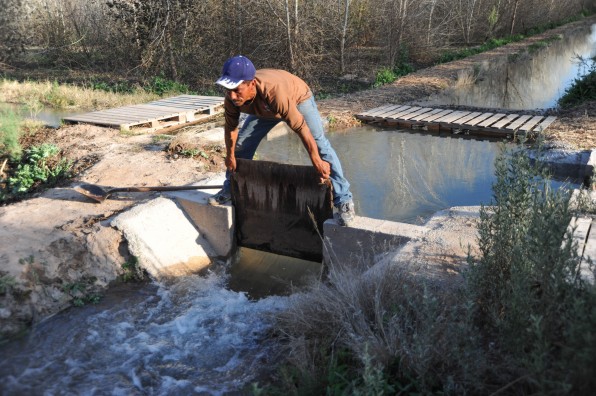In the delta community of Miguel Alemán, situated along the Colorado River corridor that forms the border between Mexico and Arizona, we arrive at an unlikely enterprise in this parched environment: a tree nursery.
 A few thousand cuttings of willow, mesquite, and cottonwoods are lined up in orderly fashion inside a well-tended greenhouse. Today the mother and son who live here and operate the nursery are painstakingly preparing willow cuttings. They are employees of Pronatura-Noroeste, the Mexican conservation organization that is working to restore the delta. In addition to the greenhouses, the nursery includes an eight-acre demonstration plot, where trees of various types and heights are monitored.
A few thousand cuttings of willow, mesquite, and cottonwoods are lined up in orderly fashion inside a well-tended greenhouse. Today the mother and son who live here and operate the nursery are painstakingly preparing willow cuttings. They are employees of Pronatura-Noroeste, the Mexican conservation organization that is working to restore the delta. In addition to the greenhouses, the nursery includes an eight-acre demonstration plot, where trees of various types and heights are monitored.
While it appears homespun, this enterprise is serious business. Last year, the nursery produced 80,000 trees – half of them mesquite, a quarter of them cottonwood, and a quarter willow. Re-creating riparian habitat by planting these native trees is a core activity to restore the delta.
But first, vast areas of salt cedar, or tamarisk, must be cleared. Since upstream dams and diversions have siphoned away the Colorado River’s water, the tenacious, salt-tolerant invader has taken over vast areas of the delta.
This clearing, replanting, and tending requires both labor and water, and here in the delta, a unique solution has been devised to acquire both.
True “Green Jobs”
Under a temporary employment program somewhat similar to South Africa’s innovative Working for Water Program, local people are paid by the Mexican government to clear the land of the tenacious salt cedar.
In Miguel Alemán, we stop by a dried-out river meander in the Colorado’s floodplain, where workers have cleared 200 acres (80 hectares). This year 30 percent of this area will be re-vegetated with young willows and other native trees from Pronatura’s nursery.
All together, Pronatura and its conservation partners plan to return native riparian trees to 500 acres (200 hectares) of this portion of the floodplain.
And what about a source of water to sustain the trees?
Enter the local farming community, a crucial partner in the delta’s restoration, along with the Colorado River Delta Water Trust, the first water bank in Mexico dedicated to acquiring water for environmental purposes.
Mexicali Valley farm families are voluntarily selling water rights to the Delta Water Trust, established in Mexico in 2008 through a partnership of Pronatural Noroeste and the US-based Sonoran Institute and Environmental Defense Fund. The water trust pays fair market value for the water rights and then uses the water to restore wetlands and riparian forests in the delta.
The transactions appear to create a win-win for all parties.
Farmers Play an Important Role
Of the roughly 12,000 farmers in the Mexicali Valley, most have small farms of less than 50 acres (20 hectares), according to Yamilette Carrillo, a post-doctoral student at the University of Arizona and consultant to Pronatura, who has interviewed more than 500 farmers in the region.
About 70 percent of the acreage is planted in wheat, 20 percent in cotton, and the remainder in alfalfa and vegetables.
Farmers sell their water rights for different reasons, according to Carrillo. Some wish to retire and do not have any children interested in taking over the business. Others pass away, and their families wish to put the water rights up for sale.
In some cases it’s purely good economics.
After a major earthquake in 2010 destroyed some of the region’s irrigation infrastructure, the value of water rights roughly doubled. For some small wheat farmers, the value of their water rights is now seven times their annual income, so many choose to sell their rights and move on to other work.
“The income from selling their water rights gives them some financial relief,” says Enrique Guillen, an irrigation engineer formerly with CONAGUA, Mexico’s National Water Commission, who now works with Pronatura Noroeste.
And many farmers favor selling their rights to the Delta Water Trust rather than to a city like Tijuana, because the water is used locally to revitalize the landscape, bringing back the beautiful trees of olden days and the birds along with them.
The restoration projects also create jobs, Guillen says. Pointing to locals planting trees and managing the water delivery at a restoration site we have come to visit, Guillen remarks, “These people working for Sonoran Institute didn’t use to have a job.”
I keep pressing to see if there’s some unspoken downside to the sale of water rights to the Delta Water Trust, but I hear and find none. The trust puts more income in poor farmers’ pockets, rejuvenates the land where many of these farm families have lived for generations, and creates jobs – all at the same time.
If the face of delta restoration looks like this, more of it would seem to be a very good thing. With the signing in late 2012 of Minute 319, a binational agreement to return flows to the delta, more restoration is assured.
As the sun drops lower in the sky, Aurelio Alfaro Rodríguez with the Sonoran Institute maneuvers his shovel to open a wooden gate in a hand-dug canal at the restoration site. Water flows by gravity through the channel to a field of young cottonwoods and willows. Birds rustle quietly in the trees.
Source: http://voices.nationalgeographic.com/
Dear User/Visitor! Please, answer on our questions: tick off one of the positions – your answer will make us able to improve our site and make it more interesting and useful!

